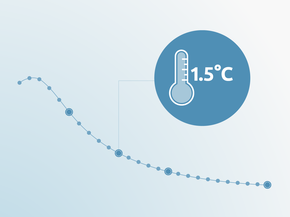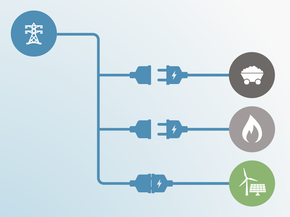Current Policy Projections
Overview
Emissions in the EU28 have been decreasing since 1990. In 2015, emissions (excl. LULUCF) were 24% below 1990 levels. After a steep decline in 2009 due to the recession, and an upward spike following the recovery in 2010, they dropped continuously until 2014. Emissions grew again by 0.5% in 2015, mainly due to higher road transport demand and higher heating demand (European Environmental Agency 2017a). To some degree, this rise was lessened by an increasing role of renewables, which allowed savings of 436 MtCO2 (European Environmental Agency 2017c).
Initial projections for 2016 indicate an emissions decrease by 0.4%, resulting mainly from a significant decrease in emissions from the power sector of 4.5% (Eurostat 2017), primarily driven by a switch from coal to gas, half of which happened in the United Kingdom, where coal plant closures - driven by the increase in carbon price support - led to a 58% decrease in coal power production. At the same time, power generation from coal decreased only slightly in Germany (-4%) and Poland (-1%) and increased in the Czech Republic (+2%) (Agora Energiewende and Sandbag 2017).
According to our analysis, the future emissions projections under the EU’s currently implemented policies continue the past downward trend with similar—or slightly decreasing—reduction rates each year, depending on the scenario adopted. While emissions decreased by an average of 1.1% per year between 1990 and 2014, they are projected to decrease by between 0.9% according to the EEA’s estimates and 1.4% according to the PRIMES projections per year until 2020. For the period to 2030 the projected decrease is 0.6% and 1.4% per year respectively. According to the two scenarios, emissions are estimated to be between 3.9 and 4.0 GtCO2e (a 28–31% reduction below 1990) in 2020 and between 3.4 GtCO2e and 3.8 GtCO2e (31–40% below 1990) in 2030. The share of renewables projected by PRIMES (slightly over 24% in 2030) is below the EU target of 27%.
Current policy projections include the EU ETS, the Effort Sharing Directive, the Energy Efficiency Directive and a wide range of other EU wide regulations influencing GHG emissions such as the Renewable Energy Directive. It also includes the most important national policies. However, these scenarios do not include the effects of policy proposals currently being discussed in the EU. These proposals, which will determine the European energy and climate framework for the period after 2020, can be grouped in three streams:
- Reform of the EU ETS,
- division of emissions reduction targets between the EU member states in the non-EU ETS sectors as well as the LULUCF regulation, and
- negotiations over numerous proposals tabled by the Commission in the framework of the Winter Package in November 2016. These proposals will affect both, the EU ETS and non-EU ETS sectors.
The reform of the EU ETS - the EU’s flagship climate policy mechanism - aims at increasing its effectiveness in emissions reduction in the power and industry sectors during Phase 4 (2021–2030). This is necessary to achieve emissions reductions in the energy and industry sectors in 2030 by 43% below 2005 levels (48% below 1990 levels). Between 2005 and 2016, emissions from the sectors currently covered by the EU ETS decreased by 26% (European Environmental Agency 2017b). This has led to a further increase in the oversupply of allowances, which in 2016 was estimated at almost 3.2 GtCO2, equivalent to almost 180% of the projected emissions in the EU ETS in that year (AgoraEnergiewende & Sandbag 2017). The resulting low price of allowances has contributed to an increase of the EU ETS emissions by 0.5% in 2017 reversing the declining trend for the first time in 7 years (Platts 2018).
To reach the “at least 40% from 1990” emissions reduction target, in October 2014 the European Council agreed that emissions in the non-EU ETS sector would have to decrease by 30% by 2030 below 2005 levels (35% below 1990). Different from the EU ETS, for which targets are set at the European level, in the non-EU ETS sector each member state will be given a binding emissions reduction target between 0 and 40% below 2005 levels. This will affect numerous sectors, especially transport and buildings.
The main weakness of the European Commission’s proposal for effort sharing in the non-EU ETS sector was that it took the average emissions in 2016–2018 as the 2020 starting point for the emissions reduction trajectory (European Commission 2016i). Since the emissions in 2020 are projected to be 3% lower than in 2016–2018, according to some estimates this would inflate the total emissions budget by 532 MtCO2 (CAN Europe 2017). The European Parliament strengthened this proposal suggesting the calculation of the trajectory starts in 2018, thus leading to a lower emissions cap in 2020. Should the emissions in 2020 turn out to be lower than those resulting from the 2018 trajectory, this lower level should be taken as the starting point of the trajectory (European Parliament 2017a). In comparison to the Commission’s proposal, this would result in a more stringent trajectory significantly reducing the amount of emissions that member states could emit while still reaching their respective 2030 targets in the non-ETS sectors. In December 2017 the Council and the Parliament reached a provisional deal according to which the average emissions from 2016-2018 will be taken as the beginning of the trajectory as suggested by the Commission. But the starting point will either be 2019 or 2020, whichever will result in lower allocation for a member state (European Parliament and the Council of the European Union 2017).
Reducing overall energy consumption would make it easier and cheaper to reduce the EU’s GHG emissions and there exists a significant unrealised energy efficiency potential (Deloitte 2016; Fraunhofer 2014). The EU’s 2020 target requires limiting primary energy consumption to 1.483 Mtoe (41.9 TJ). A continuous reduction in energy consumption between 2010 and 2014 decreased the gap between this target and primary energy consumption to 1.7%. However, in 2015, the trend reversed and the gap increased to 4% in 2016 (Eurostat 2018). The more recent numbers for 2017 that show an increase in electricity consumption by 1% (Agora Energiewende and Sandbag 2018) make it clear that more action is necessary in this area.
In the meantime, there is a debate about the energy efficiency target for 2030. Departing from the initial suggestion of the Council (European Council 2014) the Commission proposed to increase the energy efficiency target for 2030 from 27% to 30% compared to a business as usual (BAU) scenario which is set by the European Commission. This would correspond to a drop in final energy use by 17% compared to 2005 (European Commission 2016e). In June 2017 the Council agreed to increase its 2030 energy efficiency target to 30% below BAU which would lead to the consumption of no more than 1.321 Mtoe of primary energy in that year (Council of the European Union 2017d). In its position from January 2018 the European Parliament suggested increasing this target to 35% and establishment of national energy efficiency targets (European Parliament 2018a). The result of the negotiations between the Council and the Parliament will determine EU’s energy efficiency goal for 2030.
Energy supply
Emissions from the energy sector are influenced to a varied degree by the development of renewables, fuel switching and decreasing energy use resulting from improvement of energy efficiency. Two thirds of emissions in the EU’s power sector in 2017 were coming from coal-fired power plants (Agora Energiewende and Sandbag 2018). To be compatible with the Paris Agreement temperature limit this share needs to be reduced significantly in the coming decade (Climate Action Tracker 2016; Climate Analytics 2017). Instead, power production from the most carbon intensive source of energy, lignite, increased by 2% in 2017 after only a modest decline in the preceding years (Agora Energiewende and Sandbag 2018).
To decrease the oversupply of allowances in the framework of the EU ETS, which covers 45% of the emissions from close to 11,000 units, such as power plants, steel or cement plants, the annual emissions cap for the emitters covered by the EU ETS mechanism, after 2020 will be decreasing annually by 2.2%, instead of 1.74% in the current phase. To decrease the oversupply of allowances, more emissions will be transferred to the Market Stability Reserve (MSR). The MSR was established in 2015 to store the 900 million allowances that were already taken from the market before in an effort to decrease the oversupply. According to the decision establishing it, starting in 2019, 12% of the allowances in circulation were to be transferred to the MSR as long as the oversupply exceeds 833 million allowances (European Parliament and the Council of the European Union 2015a). The recent reform of the EU ETS will double that number by 2023, which will result in accelerating the decrease of the oversupply and will potentially result in higher prices. An additional improvement is the decision that unless decided otherwise beforehand, in 2024 all allowances in the MSR exceeding the number of allowances auctioned during the previous year, will be cancelled (European Parliament and the Council of the European Union 2018). This reduces the threat that coal-phase outs—or the introduction of a carbon tax in some countries—could lead to a lasting oversupply of allowances in the EU ETS, resulting in their lower price and thus higher emissions in other countries. However, keeping in mind the significant oversupply of allowances available on the market, which in 2017 was estimated at 3.3 GtCO2, equivalent to almost 190% of the projected emissions in the EU ETS in that year (Agora Energiewende and Sandbag 2018), the impact on the price of allowances may only be visible in the longer term. Nonetheless, four months after the agreement over the EU ETS reform was reached the price of allowances exceeded 10€ for the first time since 2013 (EEX 2018).
The low carbon prices mobilised some European leaders to suggest measures that would significantly increase the carbon price. In September 2017 French President Emmanuel Macron suggested the introduction of a “significant price floor” for carbon, pointing out that anything below €25 to €30 was not effective (Ouest France 2017), whereas the new Dutch government announced the introduction of a “CO2 minimum price in the electricity sector” (Dutch Government 2017) and urged the EU to increase its 2030 emissions reduction target to 55% (Climate Home 2018), which would have significant repercussions for the speed of the EU ETS emissions cap decrease. In its coalition agreement, the three parties forming the new German government declared their willingness to further strengthen the EU ETS (CDU and CSU and SPD 2018). It remains to be seen if and how these declarations will be implemented.
The price of allowances influences not only the fuel mix in the EU, but also the amount of resources available for a transition away from coal. According to a 2010 Commissions’ decision, in the framework of NER300 programme, revenues from the sale of 300 million allowances should be awarded to finance commercial demonstration renewable energy and CCS projects (European Commission 2010). Building on the experiences with the NER300, in Phase 4 of the EU ETS an “Innovation Fund” will be created, funded from auctioning 400 million allowances to support the development of innovative renewable sources of energy, storage technologies, and “environmentally safe carbon capture and utilisation”. EU countries with a GDP per capita below 60% of the EU average will also benefit from a “Modernisation Fund” financed from auctioning 2% of all allowances. In addition to funding energy efficiency, renewables, energy storage and modernisation of the energy grid, it will also support a just transition in carbon-dependent regions (Council of the European Union 2017b).
In addition to the EU ETS reform and the potential for a carbon tax, emissions from the energy sector will also be influenced by the negotiations over the proposals for the renewable energy directive (European Commission 2016g). New impulses for the development of renewable sources of energy are needed as the current rate of increase will not make it possible to replace fossil fuel at a speed required by the Paris Agreement-compatible emissions pathway. The additional RES-E capacity installed in the years 2014–2016 was over 40% lower than the capacity installed in the period 2010–2012 (WindEurope 2017), which flies in the face of global trends where renewable capacity growth is accelerating. With 15.7 GW installed in wind and 6 GW in solar, last year saw an increase in renewables’ deployment (WindEurope 2018). As a result, the share of electricity from renewables reached 30% in 2017, an increase by 0.2% in comparison to 2016 (Agora Energiewende and Sandbag 2018). But this growth is expected to be temporary: from 2019 new installations in Germany will no longer benefit from the feed-in tariffs. Instead they will have to participate in the auctioning system with a limited total capacity (BMWi 2017). Should the threat of a significant slowdown in the development of wind energy in Germany materialise (Maslaton 2017), the EU would remain far behind other countries and regions in terms of renewables investment. In 2017, EU investments in clean energy were only 0.9% above those of the United States—and the lowest since 2007 (BNEF 2018).
The future of renewables in the EU will, to a significant degree, be determined by the outcome of the interinstitutional negotiations between the Council and the Parliament. In December 2017, the Council officially adopted its position to include the 27% by 2030 target for renewables in the energy mix, which had been agreed in 2014. However, instead of setting obligatory national targets, the Council suggested allowing member states to define their contributions to achieving this EU-wide goal (Council of the European Union 2017c). The position of the European Parliament was adopted in January 2018 with a significant majority of 492 votes for and 88 against. It called for increasing the 2030 renewable energy target to 35%. The EU-wide target should be accompanied by national targets from which countries could deviate only “in duly substantiated, measurable and verifiable circumstances, based on objective and non-discriminatory criteria”. (European Parliament 2018b). The final renewable energy target will be determined in the process of inter-institutional negotiations (Trilogue). In its assessment published in February 2018, the International Renewable Energy Agency (IRENA) confirmed that the EU could cost-effectively increase the share of renewables to 34% by the end of the next decade, thus strengthening the position of the European Parliament (IRENA 2018).
A related set of measures with significant impact on emissions in the short term are the considerations or commitments of some governments to phase out coal from the power sector: France and Sweden by 2022, Denmark by 2023, the United Kingdom, Italy, and Austria by 2025, Finland and Portugal by 2030s. Closing all five remaining coal-fired power plants by 2030 is also part of the coalition pact of the new Dutch government (Reuters 2017a). These phase-out positions cover 26% of present EU coal capacity. While the level of commitments and the probability of implementation differ between these countries, such declarations send a clear signal that the end of the age of coal in the EU is approaching. However, member states with the highest share of coal-fired power plants such as Germany and Poland that cover about 50% of EU coal capacity have not yet taken similar decisions. Whereas in Germany a newly created commission should address this issue and determine the date for coal phase out (CDU and CSU and SPD 2018), Poland is instead planning the construction of new coal-fired power plants (Reuters 2017b).
Faced with the decreasing competitiveness of their coal-fired power plants, resulting from decreasing utilisation rates (The Carbon Tracker Initiative 2017), some EU member states (e.g. Poland) are planning to introduce capacity markets which can be considered as subsidies for conventional power plants. To prevent this, in its proposal for regulation on the internal market for electricity, the Commission suggested excluding units with emissions higher than 550g/kWh from capacity payments (European Commission 2016f). In December 2017, the EU member state representatives significantly weakened this requirement. According to the Council’s position, new installations with emissions higher than 550g CO2/kWh will be allowed to receive payments for readiness in the framework of capacity markets until 2025. For existing plants with emissions higher than 500g CO2/kWh this will be possible until 2030 or even 2035 if a contract for payments has been concluded before 31 December 2030 (Council of Ministers 2017). This may allow countries planning and building new coal-fired power plants, especially Poland, to misuse capacity payments to finance otherwise unprofitable, carbon intensive investments (Reuters 2017c).
The role of coal in the European power sector may also decrease due to the adoption of the new “Best Available Technique (BAT)” conclusions for Large Combustion Plants by the European Commission in July 2017 (European Commission 2017a). These new standards, issued by the Commission in accordance with the Industrial Emissions Directive (European Parliament and the Council of the European Union 2010b), and which all coal-fired power plants in the EU need to meet by 2021, are currently exceeded by 82% of the installations. The combined cost of their upgrade amounts to between €8-14.5 billion (DNV GL-Energy 2017)1. Faced with such costs, and increasing competition from renewables, many operators may decide to shut down their plants instead of upgrading them.
1 | Minimum estimate assumes costs of either NOx or SO2 reductions taking the higher number of the two single measures (SO2 for EU). Maximum estimate assumes cost of NOx, SO2 and dust without cost overlap.
Industry
As the EU ETS covers all installations with annual emissions exceeding 25 ktCO2, it also includes emissions from the energy intensive industries, such as cement, steel and chemicals. However, to decrease the threat of carbon leakage, conditional on the fulfilment of additional criteria, companies in these sectors receive free allowances up to the average emissions of the 10% most efficient installations in the sector or subsector in the years 2007–2008 (European Parliament and the Council of the European Union 2014a). The proposal for the EU ETS reform post 2020 aims at adapting the benchmarks for free allocation of allowances to reflect the technological improvements since 2007–2008 (European Commission 2015b). Reflecting more recent improvements in energy efficiency of the best 10% of installations would also decrease the amount of free allowances received, thus increasing the pressure to increase investment in energy efficiency.
At the same time, part of the resources in the aforementioned Innovation Fund should be spent on “industrial innovation in low-carbon technologies and processes”. This includes deployment of carbon capture and storage (CCS) as well as utilisation (CCU) (Council of the European Union 2017b).
The Industrial Emissions Directive (EID), adopted in 2010, also plays a role in reducing emissions from large industrial installations. The EID aims at reducing the emissions of a number of pollutants, including greenhouse gases, by requiring around 50,000 installations undertaking industrial activities to receive a permit showing that they operate according to the Best Available Techniques (BAT) (European Parliament and the Council of the European Union 2010b). This results in higher energy efficiency and lower emissions. While around 11,000 installations covered under the EU ETS are exempted from complying with standards relating to GHG emissions, it does influence emissions from the almost 40,000 remaining installations that—according to the EID—require a permit to operate.
Transport
Despite the decreasing emissions intensity of passenger cars in the EU (European Commission 2017e), emissions in the transport sector, excluding aviation, increased by almost 16% between 1990 and 2015 (EEA 2017), driven by increasing activity in road transport, both for passengers and freight (European Environmental Agency 2017a). This trend runs contrary to the EU’s goal of reducing emissions by 60% below 1990 levels by 2050 adopted in the Roadmap of the European Commission from 2011 (European Commission 2011a).
The European Union has a number of policies influencing emissions from the transport sector. The Renewable Energy Directive from 2009 introduced a 10% target for energy from renewable sources in transport by 2020 (European Parliament and the Council of the European Union 2009b). Due to the potentially negative impact of the first generation of biofuels on emissions from the LULUCF sector in other countries, in 2015 the role of certain biofuels and bioliquids in achieving this target was limited to 7%, with the rest having to be met by advanced biofuels and greater use of electricity in the transport sector (European Parliament and the Council of the European Union 2015b). The draft of the renewable energy directive currently under discussion suggests further reducing this share to 3.8% (European Commission 2016g).
The EU regulation from 2009 (amended in 2014) introduced efficiency and CO2 emissions standards for new passenger cars, with annually increasing stringency until 2020 (European Parliament and the Council of the European Union 2009c, 2014d). Separate efficiency standards have also been introduced for vans (European Parliament and the Council of the European Union 2011, 2014c).
In July 2016, the Commission presented the “European Strategy for low-emission mobility”, which suggested a number of measures aimed at accelerating emissions reduction in the transport sector. These measures include increasing the use of digital technologies in the sector, fairer taxation that would improve the competitiveness of railways, and development of infrastructure that would speed up the market uptake of alternative modes of transport, such as electric recharging points, natural gas filling stations and hydrogen filling stations. It has also proposed new and more stringent tests for emissions from cars and vans (European Commission 2016a).
Building on these suggestions, in May 2017 the Commission presented a package of initiatives titled “Europe on the Move”, which included a proposal on monitoring and reporting CO2 emissions from heavy-duty vehicles, and a suggestion to foster e-mobility through the introduction of EU-wide technical specifications (European Commission 2017c). This package was complemented by a proposal for new emissions standards for passenger cars and light commercial vehicles that was announced in November 2017. According to these, the average emissions of the EU fleet of new cars are to decrease by 15% by 2025, and 30% by 2030, both below 2021 levels. The Commission estimates that, if adopted, these new standards would lead to emissions reductions of 170 MtCO2 combined over the next decade (European Commission 2017d). Throughout 2018 this proposal will be reviewed and adopted by the European Parliament and the Council.
One of the options available for car manufacturers to reduce the average emissions of their cars is to increase the availability and sale of zero and low-emissions vehicles. One of the major limits hindering their market uptake is underdeveloped charging infrastructure. In 2014 the European Commission adopted a directive obliging member states to ensure that enough publicly available charging stations (at least one for every ten vehicles projected to be on the road) are built in the EU by the end of 2020., It also encouraged member states to facilitate building charging stations in maritime and inland waterways, as well as at airports to allow ships and planes to use electricity while stationary instead of running their engines (European Parliament and the Council of the European Union 2014b). Another measure to promote e-mobility has been introduced in the recast of the Energy Performance Buildings Directive (EPBD) agreed upon by the European Parliament and the Council in December 2017. According to EPBD, new residential buildings and those undergoing major renovations, with more than ten parking spaces, shall be equipped with an adequate pre-cabling or pre-tubing to enable the installation of recharging points for electric vehicles for every parking space (European Parliament 2017c).
While the measures adopted and suggested by the Commission could change the trend of rising emissions from the transport sector, it is not clear whether they would allow the EU to meet its “at least 60%” emissions reduction target for the transport sector by 2050 (European Commission 2011a). Emissions reductions can be accelerated by governmental measures that lead to the development of e-mobility such as tax credits, premiums and non-financial benefits in the form of free parking or the right to use bus lanes for electric cars as well as investment in production facilities which increases acceptance at the local level (Sierzchula et al. 2014). Introduction of some of these measures in some member states has led to an increase in the sale of electrically-chargeable vehicles to almost 216,000 vehicles in 2017 corresponding to 1.4 % of all passenger cars sold in the EU in 2017, and an increase by 39 % in comparison to 2016 (ACEA 2018). Nonetheless this was far behind China where electric vehicles reached a market share of 2.1% (Clean Technica 2018) and other regions such as Norway or California. Meeting the Paris Agreement-compatible emissions trajectory requires a complete phasing out of the sale of combustion vehicles well before 2035 ((Sterl et al. 2016), a goal that would require a much more decisive action on behalf of the European Union.
Decarbonisation of the transport sector in the EU is further strengthened by the discussions about banning the sale of cars with combustion engines by some member states, e.g. the Netherlands by 2030 (Dutch Government 2017), the United Kingdom and France by 2040 (WEF 2017). But the EU as a whole has not yet addressed this issue, and now appears to be falling behind developments in China, Norway and California.
Buildings
Emissions from the buildings sector in the EU are regulated by the Energy Performance Buildings Directive (EPBD Directive). As part of the directive, it obliges member states to introduce minimum energy performance requirements and ensure that, from 2021, all new buildings are “nearly zero energy buildings” (NZEB). While defining a NZEB as a building with a very high energy performance, whose energy needs are covered largely from renewable sources of energy, it left the definition of the exact energy consumption level of such building to the member states (European Parliament 2010). According to the Commission’s estimates, the EPBD Directive has already contributed to additional emissions reduction of 63 MtCO2 in 2013 (European Commission 2016d).
A major challenge for the EU is the low rate of deep renovation of the existing building stock that would reduce energy consumption and thus emissions. The current renovation rate amounts to between 1–2% of the total stock, but could be significantly increased: 35% of the EU’s building stock is over 50 years old (European Parliament 2016). The deep renovation rate of residential buildings differs significantly between the EU member states: with 2% in France, 1.5% in Germany, to 0.12% in Poland and 0.08% in Spain (ZEBRA2020 2017). An increase of the renovation rate to 5% would be necessary to make emissions from the building sector compatible with the 1.5°C temperature increase limit (CAT 2016). To increase the renovation rate, in December 2017 European Parliament and the Council agreed on a Commission’s proposal amending the EPBD Directive, which obliges each member state to submit a long-term renovation strategy leading to full decarbonisation of its building stock by 2050, with a specific milestones for 2030, targeting especially the worst-performing building stock (Council of the European Union 2017a). A report prepared for the European Parliament noted that to increase the rate of renovation it is necessary to raise awareness about efficiency options, raise the ambition of the renovation regulations, and increase the availability of the funding instruments for deep renovation (European Parliament 2016), measures which have not found widespread use so far.
Much more effective has been European legislation dealing with the energy efficiency of household appliances. The Ecodesign and the Energy Labelling directives, adopted in 2009 and 2010, respectively (European Parliament and the Council of the European Union 2009a, 2010a) is set to reduce emissions by 315 MtCO2eq in 2020 and 515 MtCO2eq(European Commission 2017b) . The working plan for 2016–2019 includes measures that, combined, would lead to primary energy savings equivalent of over 100 TWh in 2030 (European Commission 2016b).
Forestry
Emissions from LULUCF have so far not been included in either the EU ETS or non-EU ETS sectors. This is set to change with the Commission’s proposal for regulation that aims at including the GHGs emissions and removals from this sector in its 2030 climate and energy framework. After the agreement between European Parliament and the Council the regulation should be adopted in early 2018. The Regulation includes a no-debit rule meaning that emissions from deforestation could be offset by either afforestation or improved management of the existing forests (European Commission 2016h). However, this target is weakened by the possibility to use emissions reduction in LULUCF that will take place in the period 2021–2025 to offset emissions in the second half of the decade. In addition, net removals can also be used to comply with the targets in the non-EU ETS sectors by up to 280 MtCO2 in the period 2021–2030 (European Commission 2016h).
The regulation also introduces flexibility on the accounting of emissions reductions from managed forests amounting to up to 360 MtCO2 in the period 2021-2030. In addition, Finland will be granted additional compensation of 10 MtCO₂ for the 2021–2030 period “in view of the special circumstances of its forestry sector”. However, EU member states will only be activating this ‘managed forest land’ flexibility mechanism if the EU collectively meets the ‘no-debit’ rule (European Parliament 2018d).
Further analysis
Latest publications
Stay informed
Subscribe to our newsletter






